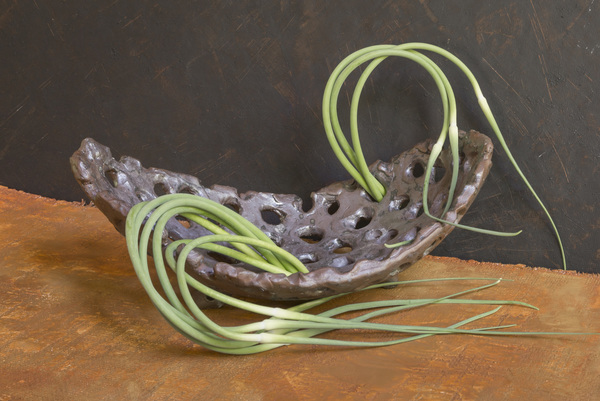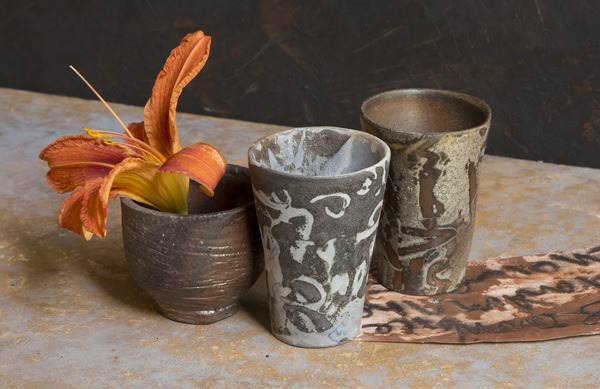One is making a kind of music in the way that one might make a garden. One is carefully constructing seeds, or finding seeds, carefully planting them and then letting them have their life. And that life isn't necessarily exactly what you'd envisaged for them. It's characteristic of the kind of work that I do that I'm really not aware of how the final result is going to look or sound. So in fact, I'm deliberately constructing systems that will put me in the same position as any other member of the audience. I want to be surprised by it as well. And indeed, I often am.
Recently in solstice Category
After being slightly frustrated by putting metal handles on teapots, I took a long break wandering through a wet garden center, a friend's garden, and my own irregular rows. I needed distance on my efforts, so I enjoyed assessing the ways our gardens have taken off, investigating what the deer have been eating, and enjoying the unplanted surprises like the volunteer squash.
Brian Eno in describing his process of making music says:
One is making a kind of music in the way that one might make a garden. One is carefully constructing seeds, or finding seeds, carefully planting them and then letting them have their life. And that life isn't necessarily exactly what you'd envisaged for them. It's characteristic of the kind of work that I do that I'm really not aware of how the final result is going to look or sound. So in fact, I'm deliberately constructing systems that will put me in the same position as any other member of the audience. I want to be surprised by it as well. And indeed, I often am.
One is making a kind of music in the way that one might make a garden. One is carefully constructing seeds, or finding seeds, carefully planting them and then letting them have their life. And that life isn't necessarily exactly what you'd envisaged for them. It's characteristic of the kind of work that I do that I'm really not aware of how the final result is going to look or sound. So in fact, I'm deliberately constructing systems that will put me in the same position as any other member of the audience. I want to be surprised by it as well. And indeed, I often am.
Today I looked to see if I have any ripe blueberries, but no. I checked the peas, which I am disappointed by this year. I decided to try some new varieties and I don't like them as much as my old standbys. As I wandered I noticed the first daylilies are blooming. The orange jumped out with the June energy that this month is all about. I picked one flower and walked to the studio meditating on my mother and her habit of picking single flowers for fear of damaging the plant and how she wanted to save more blossoms for the future. I put the flower head in a small cup--like she might have--next to a recent poem cup which, in turn, is based on a rough draft of a poem that she wrote.
When I work on the poem cups I often use one of my Mom's poems as a jumping off point. The poem becomes my lens of attention. I draw/write the lines, my mind focused on the
words, but without any judgment of good or bad because it is printed
backwards. Appearing inverted I don't worry about legibility or
spelling. The intention is balanced with an attention to the specificity
of the verse. This focus allows me to learn something about the
interactive mark of the hand, the expression of the material, and the
lens of attention.
The crows see me.
They stretch their glossy necks
In the tallest branches
Of green trees. I am
Possibly dangerous, I am
Entering the kingdom.
The dream of my life
Is to lie down by a slow river
And stare at the light in the trees-
To learn something by being nothing
A little while but the rich
Lens of attention.
But the crows puff their feathers and cry
Between me and the sun,
And I should go now.
They know me for what I am.
No dreamer,
They stretch their glossy necks
In the tallest branches
Of green trees. I am
Possibly dangerous, I am
Entering the kingdom.
The dream of my life
Is to lie down by a slow river
And stare at the light in the trees-
To learn something by being nothing
A little while but the rich
Lens of attention.
But the crows puff their feathers and cry
Between me and the sun,
And I should go now.
They know me for what I am.
No dreamer,
No eater of leaves.
I often feel as if I am chanting encouragement to myself as I accomplish my outdoor chores and unfurl new ideas in the studio. The new work feels as if roots in darkness are growing in unknown directions. I accomplished my winter rituals today, putting up our tree and lights, then walking the dog before sunset and lighting a bonfire to extend my outdoor hours. I huddled close to the fire as the temperature dropped, the light faded and icy stars leaned in with a moon sliver for company.
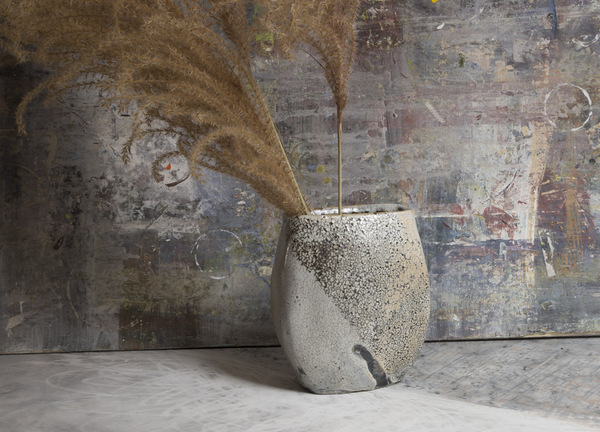 Winter Solstice Chant
Winter Solstice Chant
By Annie Finch
Vines, leaves, roots of darkness, growing,
now you are uncurled and cover our eyes
with the edge of winter sky
leaning over us in icy stars.
Vines, leaves, roots of darkness, growing,
come with your seasons, your fullness, your end.
 Winter Solstice Chant
Winter Solstice Chant By Annie Finch
Vines, leaves, roots of darkness, growing,
now you are uncurled and cover our eyes
with the edge of winter sky
leaning over us in icy stars.
Vines, leaves, roots of darkness, growing,
come with your seasons, your fullness, your end.
Tonight driving home through traffic towards the Blueridge Mountains my heart lifted at the sight of the new moon. I have come to love the waxing crescent as a sign of hope. I have learned to carry both sorrow and have faith in change like the phases of the moon. On my drive I listened to a new to me band called Ranky Tanky. The song Watch That Star caught my imagination. Part of the lyrics go, "If the star run down on the western hills, you ought to watch that star. See how it runs." I drove west, watching the star, the moon, the sky, and cataloging the different shades of darkness in the landscape as a means of coping with the season.
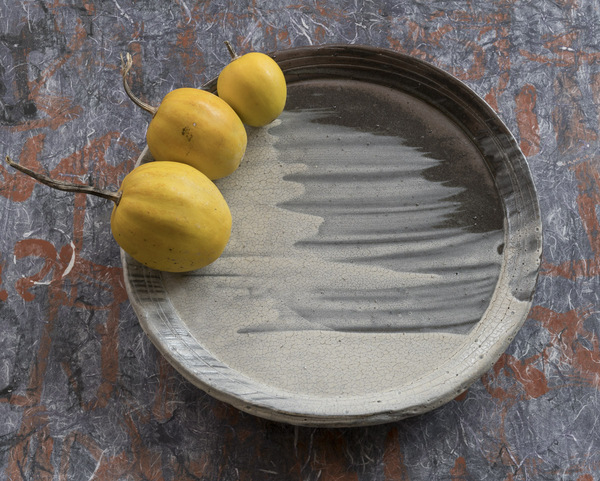 New Moon - Ted Kooser
New Moon - Ted Kooser
How much it must bear on its back,
a great ball of blue shadow,
yet somehow it shines, keeps up
an appearance. For hours tonight,
I walked beneath it, learning.
I want to be better at carrying sorrow.
If my face is a mask, formed over
the shadows that fill me,
may I smile on the world like the moon.
 New Moon - Ted Kooser
New Moon - Ted KooserHow much it must bear on its back,
a great ball of blue shadow,
yet somehow it shines, keeps up
an appearance. For hours tonight,
I walked beneath it, learning.
I want to be better at carrying sorrow.
If my face is a mask, formed over
the shadows that fill me,
may I smile on the world like the moon.
In the afternoon my studio gets dark way too fast. In the summer time I blame it on the trees that we have let grow up to close to the building, but in the winter the fault can only fall on the short days. Warren and I have been working on our 2018 calendar. I have been looking back through our photographs aiming to balance the spare aesthetic I feel in December with the memory of the lush summer. I look back to navigate future images, contemplating how to carry light forward, reminding me to stare more closely at material and its potential for expression.
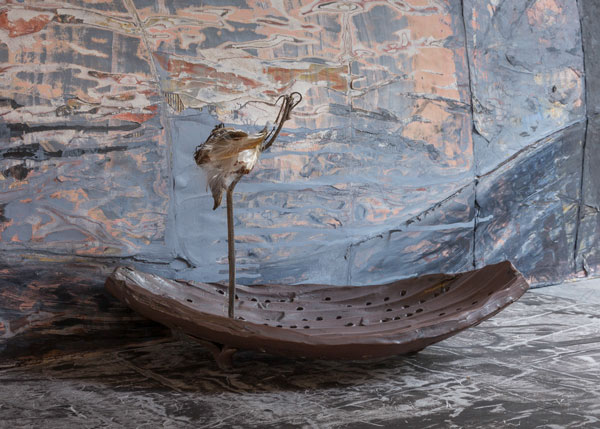 "You row forward looking back, and telling this history is part of
helping people navigate toward the future. We need a litany, a rosary, a
sutra, a mantra, a war chant for our victories. The past is set in
daylight, and it can become a torch we can carry into the night that is
the future."
"You row forward looking back, and telling this history is part of
helping people navigate toward the future. We need a litany, a rosary, a
sutra, a mantra, a war chant for our victories. The past is set in
daylight, and it can become a torch we can carry into the night that is
the future."
 "You row forward looking back, and telling this history is part of
helping people navigate toward the future. We need a litany, a rosary, a
sutra, a mantra, a war chant for our victories. The past is set in
daylight, and it can become a torch we can carry into the night that is
the future."
"You row forward looking back, and telling this history is part of
helping people navigate toward the future. We need a litany, a rosary, a
sutra, a mantra, a war chant for our victories. The past is set in
daylight, and it can become a torch we can carry into the night that is
the future."--Rebecca Solnit - from Hope in the Dark: Untold Histories, Wild Possibilities
This morning, walking before breakfast, I put one foot in front of the other studying leaf littler and seed pods. Something on the horizon caught my eye and I looked up to see a bald eagle soar above the trees in front of me, then over my head, back down our driveway past the house and finally towards the stream that feeds the pond. The soaring eagle lacked confines and lifted both my gaze and mood. My idiosyncratic path through the morning light was both our well trodden driveway and grass but also a metaphor for looking up and moving beyond merely putting one foot in front of the other.
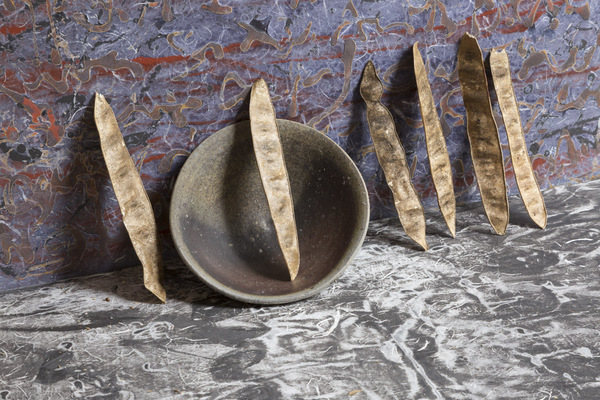 This history of walking is an amateur history, just as walking is an
amateur act. To use a walking metaphor, it trespasses through everybody
else's field -- through anatomy, anthropology, architecture, gardening,
geography, political and cultural history, literature, sexuality,
religious studies -- and doesn't stop in any of them on its long route.
For if a field of expertise can be imagined as a real field -- a nice
rectangular confine carefully tilled and yielding a specific crop -- then
the subject of walking resembles walking itself in its lack of
confines. And though the history of walking is, as part of all these fields and everyone's experience, virtually infinite, this
history of walking I am writing can only be partial, an idiosyncratic
path traced through them by one walker, with much doubling back and
looking around... The history of walking is everyone's history, and any
written version can only hope to indicate some of the more well-trodden
paths in the author's vicinity -- which is to say, the paths I trace are
not the only paths.
This history of walking is an amateur history, just as walking is an
amateur act. To use a walking metaphor, it trespasses through everybody
else's field -- through anatomy, anthropology, architecture, gardening,
geography, political and cultural history, literature, sexuality,
religious studies -- and doesn't stop in any of them on its long route.
For if a field of expertise can be imagined as a real field -- a nice
rectangular confine carefully tilled and yielding a specific crop -- then
the subject of walking resembles walking itself in its lack of
confines. And though the history of walking is, as part of all these fields and everyone's experience, virtually infinite, this
history of walking I am writing can only be partial, an idiosyncratic
path traced through them by one walker, with much doubling back and
looking around... The history of walking is everyone's history, and any
written version can only hope to indicate some of the more well-trodden
paths in the author's vicinity -- which is to say, the paths I trace are
not the only paths.
--Wanderlust: A History of Walking, by Rebecca Solnit
 This history of walking is an amateur history, just as walking is an
amateur act. To use a walking metaphor, it trespasses through everybody
else's field -- through anatomy, anthropology, architecture, gardening,
geography, political and cultural history, literature, sexuality,
religious studies -- and doesn't stop in any of them on its long route.
For if a field of expertise can be imagined as a real field -- a nice
rectangular confine carefully tilled and yielding a specific crop -- then
the subject of walking resembles walking itself in its lack of
confines. And though the history of walking is, as part of all these fields and everyone's experience, virtually infinite, this
history of walking I am writing can only be partial, an idiosyncratic
path traced through them by one walker, with much doubling back and
looking around... The history of walking is everyone's history, and any
written version can only hope to indicate some of the more well-trodden
paths in the author's vicinity -- which is to say, the paths I trace are
not the only paths.
This history of walking is an amateur history, just as walking is an
amateur act. To use a walking metaphor, it trespasses through everybody
else's field -- through anatomy, anthropology, architecture, gardening,
geography, political and cultural history, literature, sexuality,
religious studies -- and doesn't stop in any of them on its long route.
For if a field of expertise can be imagined as a real field -- a nice
rectangular confine carefully tilled and yielding a specific crop -- then
the subject of walking resembles walking itself in its lack of
confines. And though the history of walking is, as part of all these fields and everyone's experience, virtually infinite, this
history of walking I am writing can only be partial, an idiosyncratic
path traced through them by one walker, with much doubling back and
looking around... The history of walking is everyone's history, and any
written version can only hope to indicate some of the more well-trodden
paths in the author's vicinity -- which is to say, the paths I trace are
not the only paths.--Wanderlust: A History of Walking, by Rebecca Solnit
After a lovely dinner talking pots, memories and looking to the future the candles burned low. There were few pauses because there was so much interchange between friends, food and pots.
 Jeanette Winterson writes of the relationship between light and conversation:
Jeanette Winterson writes of the relationship between light and conversation:
I have noticed that when all the lights are on, people tend to talk about what they are doing--their outer lives. Sitting round in candlelight or firelight, people start to talk about how they are feeling--their inner lives. They speak subjectively, they argue less. There are longer pauses.
 Jeanette Winterson writes of the relationship between light and conversation:
Jeanette Winterson writes of the relationship between light and conversation:I have noticed that when all the lights are on, people tend to talk about what they are doing--their outer lives. Sitting round in candlelight or firelight, people start to talk about how they are feeling--their inner lives. They speak subjectively, they argue less. There are longer pauses.
My friend Mikio who owns and runs the restaurant Omen Azen for whom we make pots published a book called Talk To A Stone. It is a beautiful object about Mikio's father, Yoji and his calligraphy. The book was designed by Stefan Sagmeister, an extremely well-known graphic designer. The driving design theme of the book was to print the calligraphy on translucent paper which was then folded with reversed text printed on the opposite side of the sheet so that when folded the now readable text showed through the paper as if through a thin veil. For Mikio creating Talk To A Stone exhibited the Buddhist virtues of patience and perseverance. His restaurant is also a reflection of his commitment and approach. There are a few stones in a glass case as you enter the space. We gave him a few more last week as a reminder of long friendship, our joint trips to Maine, our fathers' love of making art and telling stories, and our daughter's future journeys. All are reflected through a veil of love and light.
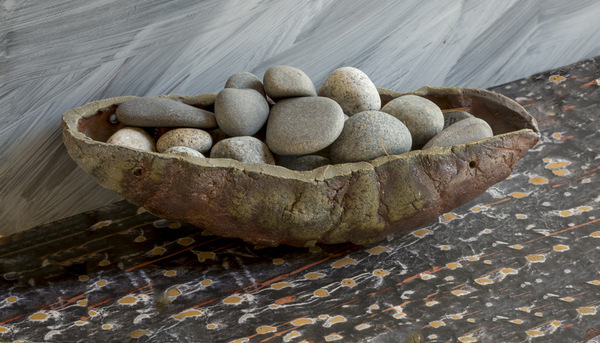 Go inside a stone
Go inside a stone
That would be my way.

 Go inside a stone
Go inside a stoneThat would be my way.
Let somebody else become a dove
Or gnash with a tiger's tooth.
I am happy to be a stone.
From the outside the stone is a riddle:
No one knows how to answer it.
Yet within, it must be cool and quiet
Even though a cow steps on it full weight,
Even though a child throws it in a river,
The stone sinks, slow, unperturbed
To the river bottom
Where the fishes come to knock on it
And listen.
I have seen sparks fly out
When two stones are rubbed.
So perhaps it is not dark inside after all;
Perhaps there is a moon shining
From somewhere, as though behind a hill--
Just enough light to make out
The strange writings, the star charts
On the inner walls.
--From Selected Early Poems
by Charles Simic. Copyright © 1999,
After my father died I ended up with the boxes that hold my mother's archives of poems. When I am working on an new series of plates I often have a look in one of the boxes. I sift through the folders of handwritten and typed and xeroxed pages and am always touched by how vibrant her poems are. When she was alive the poems seems too obvious, but now in retrospect I see how she captured the atmosphere and her thoughts--the nuances of her Greenwich Village walks, her Maine boat rides, her fears for her children, or her love of tulips and mint. I am glad to mine these collections of words to find that she captured so much as I embed them in my plates. Printed backwards they further emphasize my inherited illegible handwriting.
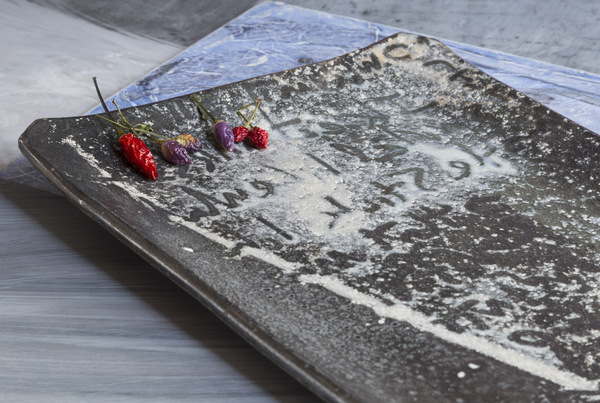 "The poetry of the earth is never dead."
"The poetry of the earth is never dead."
- John Keats
 "The poetry of the earth is never dead."
"The poetry of the earth is never dead."- John Keats
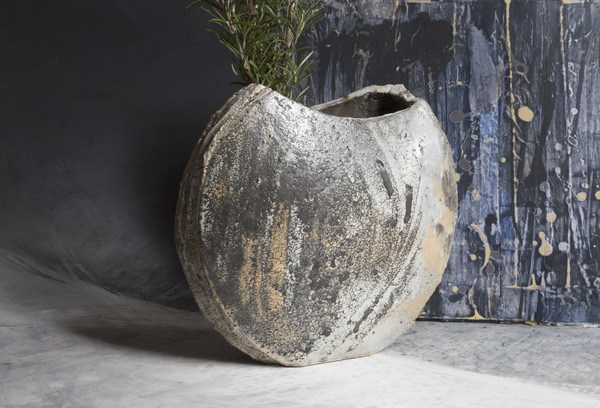 Why Are Your Poems So Dark?
Why Are Your Poems So Dark?Isn't the moon dark too,
most of the time?
And doesn't the white page
seem unfinished
without the dark stain
of alphabets?
When God demanded light,
he didn't banish darkness.
Instead he invented
ebony and crows
and that small mole
on your left cheekbone.
Or did you mean to ask
"Why are you sad so often?"
Ask the moon.
Ask what it has witnessed.
--Linda Pastan, from Poetry (August 2001)
